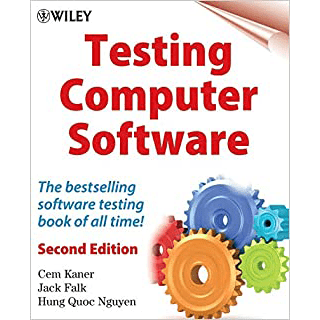The original printing of Testing Computer Software set the standard for the emerging field of test engineering with a full tour of the state of the art in managing the testing process. The reissued text makes this classic out-of-print text available once again. Though it relies heavily on older examples (including MS-DOS) and has not been updated, this text is still a worthwhile resource for practical-minded advice on the realities of testing.The best thing about Testing Computer Software is its practical point-by-point guide to everyday software testing, from creating a test plan, to writing effective bug reports, to working with programming staff and management to fix bugs.
That said, this book's early frame of reference shows how far we've come. (The book relies heavily on MS-DOS examples and features some truly embarrassing anachronisms, including the mention of testing dot-matrix printers and even EGA/VGA video modes.) The bibliography stops at sources from 1992 and features many references from the 1980s. Nowadays, automated software testing tools are the staple of any testing strategy. This book even advocates a wait-and-see approach to the "new" Microsoft Test.
These limitations aside, there is still a good deal to mine here. Much of the approach to testing is still very valid for any aspiring or working test engineer. Clearly, readers of the first edition will have little reason to upgrade to this second edition, but for anyone who appreciates a "classic" (and indeed a pioneering) text in the field of software testing, it's good to have Testing Computer Software in print again. --Richard Dragan
Topics covered: test case design, test planning, project lifecycle overview, software errors, boundary conditions, bug reports, regression testing, black box testing, software quality and reliability, managing test teams, printer testing, internationalization, and managing legal risk.
"I enjoyed reading Testing computer software. The text contains numerous highlights Offering practical advice, authoritative figures you can cite to customers and higher management, and entertaining anecdotes to share with coworkers Although some sections need updating, I still think it is a valuable training and reference source for software testers, managers, and developers." --Diomidis Spinellis; IEEE software magazine (May /June 2001))
"Deep insight and a great deal of experience is contained in this book" (Database & Network Journal, Vol 30/5 2000)
From the Inside Flap
This book will teach you how to test computer software under real-world conditions. The authors have all been test managers and software development managers at well-known Silicon Valley software companies. Successful consumer software companies have learned how to produce high-quality products under tight time and budget constraints. The book explains the testing side of that success.
Who this book is for:
* Testers and Test Managers
* Project Managers-Understand the timeline, depth of investigation, and quality of communication to hold testers accountable for.
* Programmers-Gain insight into the sources of errors in your code, understand what tests your work will have to pass, and why testers do the things they do.
* Students-Train for an entry-level position in software development.
What you will learn:
* How to find important bugs quickly
* How to describe software errors clearly
* How to create a testing plan with a minimum of paperwork
* How to design and use a bug-tracking system
* Where testing fits in the product development process
* How to test products that will be translated into other languages
* How to test for compatibility with devices, such as printers
* What laws apply to software quality
From the Back Cover
This book will teach you how to test computer software under real-world conditions. The authors have all been test managers and software development managers at well-known Silicon Valley software companies. Successful consumer software companies have learned how to produce high-quality products under tight time and budget constraints. The book explains the testing side of that success.
Who this book is for:
* Testers and Test Managers
* Project Managers-Understand the timeline, depth of investigation, and quality of communication to hold testers accountable for.
* Programmers-Gain insight into the sources of errors in your code, understand what tests your work will have to pass, and why testers do the things they do.
* Students-Train for an entry-level position in software development.
What you will learn:
* How to find important bugs quickly
* How to describe software errors clearly
* How to create a testing plan with a minimum of paperwork
* How to design and use a bug-tracking system
* Where testing fits in the product development process
* How to test products that will be translated into other languages
* How to test for compatibility with devices, such as printers
* What laws apply to software quality
About the Author
CEM KANER consults on technical and software development management issues and teaches about software testing at local universities and at several software companies. He also practices law, usually representing individual developers, small development services companies, and customers. He founded and hosts the Los Altos Workshops on Software Testing. Kaner is the senior author of Bad Software: What to Do When Software Fails (Wiley).
JACK FALK consults on software quality management and software engineering management. Jack is certified in Software Quality Engineering by the American Society of Quality. He is Vice Chair of the Santa Clara Valley Software Quality Association and an active participant in the Los Altos Workshops on Software Testing.
HUNG Q. NGUYEN is Founder, President, and CEO of softGear technology. He has worked in the computer software and hardware industries, holding management positions in engineering, quality assurance, testing, product development, and information technology, as well as making significant contributions as a tester and programmer. He is an ASQ-Certified Quality Engineer, and a senior member and San Francisco Section Certification Chairman of the American Society for Quality.
